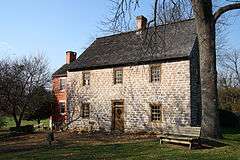Schifferstadt (Frederick, Maryland)
|
Scheifferstadt | |
 | |
  | |
| Location | 1110 Rosemont & 2nd St., W., Frederick, Maryland |
|---|---|
| Coordinates | 39°25′24″N 77°25′39″W / 39.42333°N 77.42750°WCoordinates: 39°25′24″N 77°25′39″W / 39.42333°N 77.42750°W |
| Area | 1 acre (0.40 ha) |
| Built | 1750 |
| NRHP Reference # | 74000952[1] |
| Added to NRHP | July 22, 1974 |
Schifferstadt, also known as Scheifferstadt, is the oldest standing house in Frederick, Maryland.
History
The stone abode was completed in 1758 as were the cast iron five plate stoves used to heat the rooms attest. The house stands on land purchased by German immigrant farmer Josef Brunner (later alternately spelled 'Bruner' and 'Brooner') in 1746. Brunner purchased 303 acres (123 ha) of tract land known as "Tasker's Chance" from Frederick Town (current-day Frederick) homesteader Daniel Dulany. Brunner named the property after Klein Schifferstadt, his home town in the Rhineland-Palatinate region of southwestern Germany near Mannheim.
Architecture
The sandstone for Schifferstadt's two-foot-thick walls came from a local quarry near Walkersville Maryland. In Josef Brunner's time, a stone house reflected the family’s social and financial success and stability. The work was finished by Josef's son Elias as Josef was killed in a horse accident (possibly) before the work was completed.[2] The hand-hewn wood beams were pinned together with wooden pegs. Above the windows and doors on the first floor of the building are reinforced arches made of stone, supporting the outside walls above them. The roof is considered to be unusual with kick-up and flared eaves, and features a large "wishbone" chimney. There were four "Five Plate" cast iron wood fireplace inserts that keep most of the house warm. One is still there and is the basis for dating the house at 1758 because of the casting on the plate. Much of the original construction and detailing survives, showing particular examples of German influence.[3] Schifferstadt is known to be the finest existing example of German colonial architecture in the United States.[4]
Ownership, disrepair and restoration
The house was owned by Brunner's family and descendants until the mid-19th century when it was sold (along with 94 acres) to Frederick resident Christian Steiner for $7,130. In 1899 the Steiner estate sold Schifferstadt to Edward C. Krantz for $16,000, who in turn sold the property to Frederick B. Krantz in 1926. In 1963, the Frederick B. Krantz estate was willed by his widow to daughters Evelyn A. Krantz, Olive Dinterman and Elizabeth Kirschman. By 1972 much of the original acreage had been sold and the house had fallen into a state of disrepair and endangered by development, but in July 1974 was sold by the Krantz sisters to Frederick County Landmarks Foundation. The foundation subsequently restored Schifferstadt and today operates it as an architectural and local history museum.
References
- ↑ National Park Service (2010-07-09). "National Register Information System". National Register of Historic Places. National Park Service.
- ↑ "Frederick County Landmarks Foundation". Schifferstadt. 2008-12-18.
- ↑ J. Richard Rivoire (August 1973). "National Register of Historic Places Registration: Schifferstadt" (PDF). Maryland Historical Trust. Retrieved 2016-01-01.
- ↑ "Small Museum Association". Schifferstadt Architectural Museum. 2008-12-16.
External links
- Scheifferstadt, Frederick County, including photo in 2004, at Maryland Historical Trust
- Schifferstadt Architectural Museum

